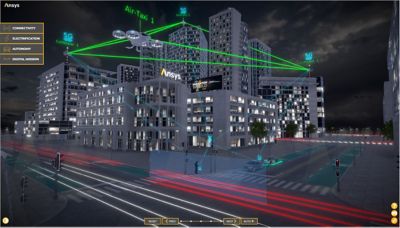-
-
Kostenlose Software für Studierende
Ansys unterstützt die nächste Generation von Ingenieur*innen
Studenten erhalten kostenlosen Zugang zu erstklassiger Simulationssoftware.
-
Verbinden Sie sich jetzt mit Ansys!
Gestalten Sie Ihre Zukunft
Stellen Sie eine Verbindung mit Ansys her, um zu erfahren, wie Simulation Ihren nächsten Durchbruch vorantreiben kann.
Länder und Regionen
Kostenlose Demoversionen
Produkte & Dienstleistungen
Lernportal
Über das Unternehmen
Back
Produkte & Dienstleistungen
Back
Lernportal
Ansys unterstützt die nächste Generation von Ingenieur*innen
Studenten erhalten kostenlosen Zugang zu erstklassiger Simulationssoftware.
Back
Über das Unternehmen
Gestalten Sie Ihre Zukunft
Stellen Sie eine Verbindung mit Ansys her, um zu erfahren, wie Simulation Ihren nächsten Durchbruch vorantreiben kann.
Kostenlose Demoversionen
ANSYS BLOG
November 4, 2022
An Update on 5G and Aircraft Safety
The U.S. aircraft industry is in the final phases of adapting aircraft and airports to address concerns over potential 5G cellular signal interference of automated landing systems. The Federal Aviation Administration (FAA) has driven the process to determine the level of risk to aircraft and safeguard against problems for low-visibility approaches — such as during inclement weather — for nearly a year by studying, experimenting, and redesigning aircraft radar altimeters.
Yet all of the problems of the past year — including the many flight delays, cancellations, reroutes, and aircraft altimeter retrofitting, along with the costs of running experiments to determine system and facility vulnerabilities — could have been avoided. With changes implemented early in the design of the radar altimeter antenna — along with 5G base station deployment planning — airports and aircraft nationwide could have been ready for the cellular service provider switch from 4G to 5G beforehand. That state of early preparedness is possible today through the employment of computational physics simulators from Ansys.

From the Top
Ansys has been covering 5G aircraft safety since the beginning. A little background information is in order here.
The 5G C-band ranges from 3.7 GHz to 3.98 GHz. First deployments are expected to activate only the lower 100 MHz of the frequency range (from 3.7-3.8 GHz). This will satisfy current expected demand, leaving two more bands of roughly 100 MHz each for future service growth needs while still providing the expected early user base the minimum 50 MHz or more of bandwidth to support high-performance upload and download service.
At first glance, there shouldn’t be any concern over potential degradation of aircraft radar altimeter operation, which uses the 4.2-4.4 GHz band. However, radar altimeters have demonstrated in the past to be highly sensitive to both in-band and out-of-band interference, which can cause incorrect altitude readings — a grave problem for airplanes conducting low-visibility landings. The worst part of this dilemma is that it could all have been avoided.
Computational physics software from Ansys can capture the multivariate complexities of this problem to help determine appropriate countermeasures. Ansys HFSS has 46 years of research and development history embedded in its code that represents much of the original foundational science of computational electromagnetics. It contains solver algorithms employing numerical methods that enable modeling and simulation of electronics and electromagnetic phenomena, ranging from microchips and multiboard systems to vehicles and spacecraft, as well as wireless network deployments in urban areas.
The Electromagnetic Interference Tool Kit (EMIT) that is part of HFSS can model and simulate both in-band and out-of-band effects on antennas, playing to one of the strengths and primary applications of HFSS: antenna design. An antenna can be virtually prototyped using HFSS, enabling designers to develop EMI-resistant antenna implementations before ever building the actual hardware. An HFSS simulation can capture maximum power output, radio beam direction, maximum permitted emissions, aircraft orientation with respect to a 5G emitter, and the full spectrum of potential sources of noise, coupling, and interference effects, along with environmental phenomena such as humidity.
This highly detailed modeling facilitates antenna development that is sufficiently robust to reject out-of-band interference, even from signals of great strength. As a result of employing HFSS, radar altimeter antennas can be made more robust against any sort of potential interference. HFSS can also demonstrate how 5G antennas can be designed, deployed, power-limited, and pointed away from approach routes in the vicinity of airports to avoid broadcasting interference signals toward aircraft.

Furthermore, by employing Ansys Systems Tool Kit (STK), a product used in the aerospace industry for physics-based modeling of environments and systems in realistic deployment scenarios, engineers can actually capture the essential physical details of airports and aircraft. Using STK with HFSS enables users to conduct flight experiments virtually, without a drop of fuel expended.
Currently, 90% of aircraft are equipped with robust radar altimeters, and 99% of airports are cleared to allow 5G C-band transmissions locally without concerns over low-visibility approaches. The FAA plans to complete this transition by mid-2023.
Ansys has been discussing this problem extensively as a regular topic. You can read about the details behind this simulation problem and its solution at the following links:
5G and Aircraft Safety: How Simulation Helps Ensure Safety
5G and Aircraft Safety Part 2: Simulating Altimeter Antenna Interference
5G and Aircraft Safety Part 3: How Simulation Can Validate Interference Scenarios